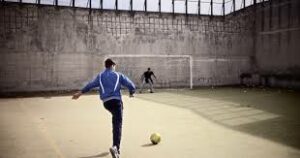 PR 4 : POLICY RECOMMENDATIONS
PR 4 : POLICY RECOMMENDATIONS
The general objective is to provide policy recommendations about sports- and through the gate support programs in prison. It will mobilize all the relevant stakeholders on identifying areas for advancing sports as a tool within a prison context and on creating policy recommendations for their joint work in the future.
NATIONAL/REGIONAL GOVERNMENT LEVEL
1. The role of sport in prisons within a ‘through the gate support’ approach should be clearly identified.
The results of the survey have shown that a wide variety of objectives have been reported. This ranges from more direct sport-related outcomes (such as active leisure participation, sport skill development, improved physical fitness) to broader social effects (such as personal and social development, social inclusion and rehabilitation, employability, …). In many cases multiple objectives have been mentioned by the respondents. Considering the difficulty to work towards multiple objectives at the same time, there is a need to prioritise.
2. The conditions under which specific objectives are expected to be achieved should be clearly identified and their feasibility should be examined.
Conditions relate to organisational aspects (such as the availability and quality of guidance, facilities, partnerships and the level of prisoners’ active involvement), as well as to policy related aspects (such as priorities of prison management). Targeting broader social objectives through sport is more complicated than working towards direct sport-related outcomes. The former requires more specific conditions including a more holistic approach (with structural and external partnerships between justice, social and sport organisations), as well as more time (with adequate follow-up after release). Consequently, a clear identification of these specific conditions is needed, as well as determining their feasibility.
3. Compliance is required from all member states to the recommended European guidelines regarding the role and organisation of sport in prison settings.
According to the European prison rules ‘Every prisoner shall be provided with the opportunity of at least one hour of exercise every day in the open air, if the weather permits (27.1) and ‘When the weather is inclement, alternative arrangements shall be made to allow prisoners to exercise (27.2)[1]’. In these key legal standards and principles related to prison management, staff and treatment of detainees the importance of: (1) appropriate installations and equipment for exercise and sport, (2) special sport activities for those prisoners who need them and (3) organisational involvement of prisoners for the provision of recreational opportunities (including but not limited to sport activities) is recognised. The last two principles are key issues when targeting broader social objectives (e.g., personal and social development, provision of non-formal educational opportunities). Furthermore, attention should be paid towards the basic principles of the European prison rules that transcend policy areas and stipulate the importance of working towards the reintegration into free society and advice EU member states to closely collaborate with outside social services to facilitate this process. Again, and aligning with the exercise and sport principles, these basic principles transcending policy areas indicate that issues related to the role and organisation of sport in prison settings should be considered. Based on the survey of the SPPF project, it appears that there is still room for growth regarding both aspects (i.e., promote access to sport and use sport as a tool for facilitating the reintegration process in collaboration with partners outside the prison walls or what is referred to as a through the gate support approach through sport programmes).
4. There is a need for a better understanding and recognition among practitioners and policy makers of the actual potential of using sport within a ‘through the gate support’ approach in prisons.
The project has clearly shown that many challenges exist to use sport within a ‘through the gate support’ approach in prisons in EU member states. Different stakeholders need to be well-informed regarding sport’s potential and its limitations. This primarily relates to supporting local providers and practitioners in how to make optimal use of sport in prison settings targeting various objectives, as well as advising and awareness raising among policymakers for recognising and having realistic expectations regarding the potential of sport programmes. Through the gate sports-based programmes can only be effective and efficient if all stakeholders involved (from different policy domains) understand that adequate organisational and financial resources in relation to the targeted objectives are required. This type of knowledge dissemination and co-creation with relevant stakeholders can best be provided through recognised (umbrella) organisations that can serve as expertise centres. These centres will then need to have a special mandate to play this role.
5. There is a need for a more systematic approach regarding the organisation and evaluation of sport activities within a ‘through the gate support’ approach in prisons.
The survey has shown that more than on third (or 39%) of the sport programmes is not evaluated. If sport programmes were evaluated, it was mostly done by prison staff. The survey has also shown that, in many cases, a clear description of how activities are organised is lacking as well (e.g., the role of sport, intensity level and frequency of practice, number and type of sports provided, the role of coach/mentor). Consequently, evaluation of sport programmes in prisons becomes difficult without a clear description of the actual process and the expected outcomes. It prevents impact measurement and does not allow to determine if there is a causal relationship between the way activities are organised and their possible effects. A systematic approach of co-creative programme development, delivery and of evaluation will provide more clarity and logic for internal and external stakeholders. Regarding the latter, this is particularly beneficial for funders as it allows for better accountability for the investments made. Such a systematic approach can be facilitated through developing and implementing a Theory of Change.
EUROPEAN GOVERNMENT LEVEL
6. There is a need for knowledge dissemination and exchange among the EU member states regarding the potential of sport programmes in prisons within a ‘through the gate support’ approach.
The ‘European Union Work Plan for Sport (2021-2024)’ refers, among other things, to the educational role of sport by regarding it “… as a framework for personal, social and learning skills and promoting tolerance, solidarity, inclusiveness as well as other sport values and EU values”. To date, however very few projects funded by the EU can be identified that have looked at the role of sport for preparing prisoners for their return to society after release. The basic principles of the European prison rules draw specific attention towards the reintegration into free society and advise Council of Europe member States to closely collaborate with outside social services to facilitate this process. These basic principles relate to the various policy areas, including but not limited to the domain of exercise and sport.
As the SPPF project has shown that distinct differences exist among EU member states regarding the conditions under which sport programmes can be organised in prisons, it cannot be expected that all member states will be able to target broader social objectives to the same extent. However, it is important that all EU member states should be well-informed about the potential of sport to prepare prisoners for their return to society. Relevant publications, as well as recommendations that have resulted from transnational projects (such as from the SPPF project) should therefore be actively promoted at the European level. Different stakeholders on national/regional level should be encouraged to take these recommendations into consideration and to work towards their actual implementation.
[1] https://search.coe.int/cm/Pages/result_details.aspx?ObjectID=09000016809ee581
 This site reflects only the author’s view and the Commission is not responsible for any use that may be made of the information it contains.
This site reflects only the author’s view and the Commission is not responsible for any use that may be made of the information it contains.

